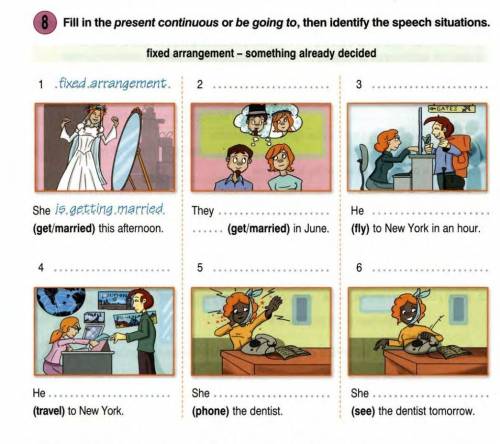Fill in the present continuous or be going to, then identify the speech situations

Другие вопросы по теме Английский язык
Популярные вопросы
- Диагонали трапеции abcd с основаниями ab и cd пересекаются в точке м. найдите...
3 - Написать текст на тему яке значення для людини має мова (на украинском...
2 - Из пластины, имеющей форму правильного треугольника площадью 9*корень из...
1 - Диагонали трапеции abcd с основаниями ab и cd пересекаются в точке м. найдите...
2 - 15) there are ………..trees in the street. a) much; b) any; c) little; d)...
2 - Краткая характеристика всеволода большое гнездо и андрея боголюбского...
1 - 1. чому тиск у трубці дорівнює атмосферному тиску ( за умови рівності рівнів...
2 - 1.при погрузке на судно 400т груза его осадка увеличилась на 40 см.определите...
1 - На высоте равностороннего треугольника со стороной 4 корень из 3 как на...
3 - Проверочное слово к слову господин...
1
1. "I ______ (study) for the math test tonight."
In this sentence, the correct form to fill in is "am going to study." We use "be going to" when we have a planned future action. The speech situation here is likely a student discussing their study plans with a friend or parent.
2. "She ______ (watch) a movie at the cinema tomorrow."
The correct form to fill in is "is going to watch." Similar to the previous sentence, we use "be going to" for planned future actions. The speech situation here can be a friend asking another about their plans for tomorrow.
3. "They ______ (have) a party on Saturday."
The correct form to fill in is "are going to have." Once again, we use "be going to" for planned future actions. The speech situation here can be a group of friends discussing their weekend plans.
4. "I ______ (visit) my grandma next week."
The correct form to fill in is "am going to visit." As mentioned before, we use "be going to" for planned future actions. The speech situation here can be a person telling a friend about their upcoming visit.
5. "He ______ (not go) to school today."
The correct form to fill in is "is not going." In this case, we use the present continuous form to talk about an action happening at the time of speaking or in the near future. The speech situation here can be a teacher or parent informing someone about a student's absence from school.
6. "We ______ (have) a picnic this weekend."
The correct form to fill in is "are going to have." Once again, we use "be going to" for planned future actions. The speech situation here can be a group of friends discussing their weekend plans.
In summary, to complete the sentences correctly, we need to use the appropriate form of the present continuous or "be going to" based on the given situations. The use of each form depends on whether the action is a planned future action (be going to) or an action happening at the time of speaking or in the near future (present continuous). By identifying the speech situations, we can understand the context in which these sentences might be used.